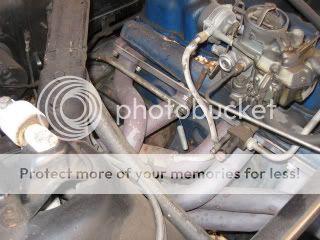Making the choke system work is fairly simple and straight forward. When I bought my Stang from a guy in NC he had dorked around with it so much it didn't function properly. Here's what I found and how I fixed it:
1) There is an internal passage thru the carb that goes to the base that sucks in the hot air. This passage has to be free and clear. The one on mine wasn't, so I cleaned it. When was the last time your carb was rebuilt?
2) The junk in the passages of my carb looked like road grime. So make sure the inlet to the tube is protected from dust, junk, crap flying around the engine compartment. After putting headers on my engine I made a new choke tube and put the open end way down near the collector between the pipes.
3) The tube MUST have some type of insulation. The cooling/radiator fan flows enough air to cool the heated air being suck thru the tube to delay and retard the opening.I put some insulation from another choke tube over the one on the Stang and the choke coil opened properly.
4) I used one insulated choke tube from a JY carb and the choke wouldn't open all the way. I gently removed the insulation and found holes in the tube. So make sure the tube is solid and the only "inlet point" is on the end.
5) Make sure the open end is touching the exhaust system or the tube is contact with it. Heat transfer is related to the area, so get as much contract as possible.
6) Set the choke coil while "cold",so go out to the car and before you fire it up, loosen the little bolts and rotate the housing so the choke plate JUST closes. You might have to have the throttle slight open with your other hand to have the choke rotate freely. More tension on the spring will delay opening. And if the plate doesn't close fully it might open prematurely. Also you will more than likely have to fiddle with it some more depending on how fast or slow the choke pulls off. But that will be a great first starting point.
7) Carbs have the greatest problems functioning in the 45-35F range. Its cold, but not really cold enough. Any changes you do to make the carb run in this temp range will probably have to be re-adjusted when it gets warmer or colder. I'm not saying to WON'T function, it just that the carb has the most difficulty in this range. So if the carb is a little finicky in this range just be aware it's the nature of the beast.


